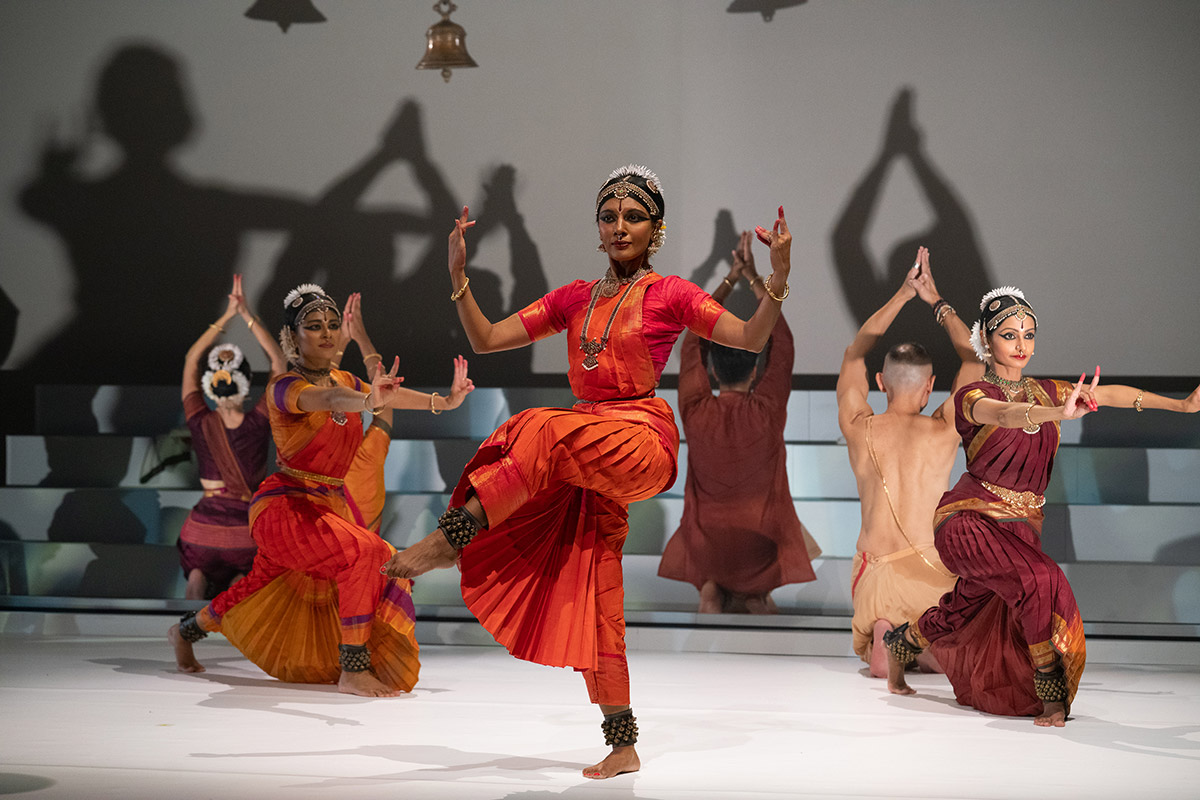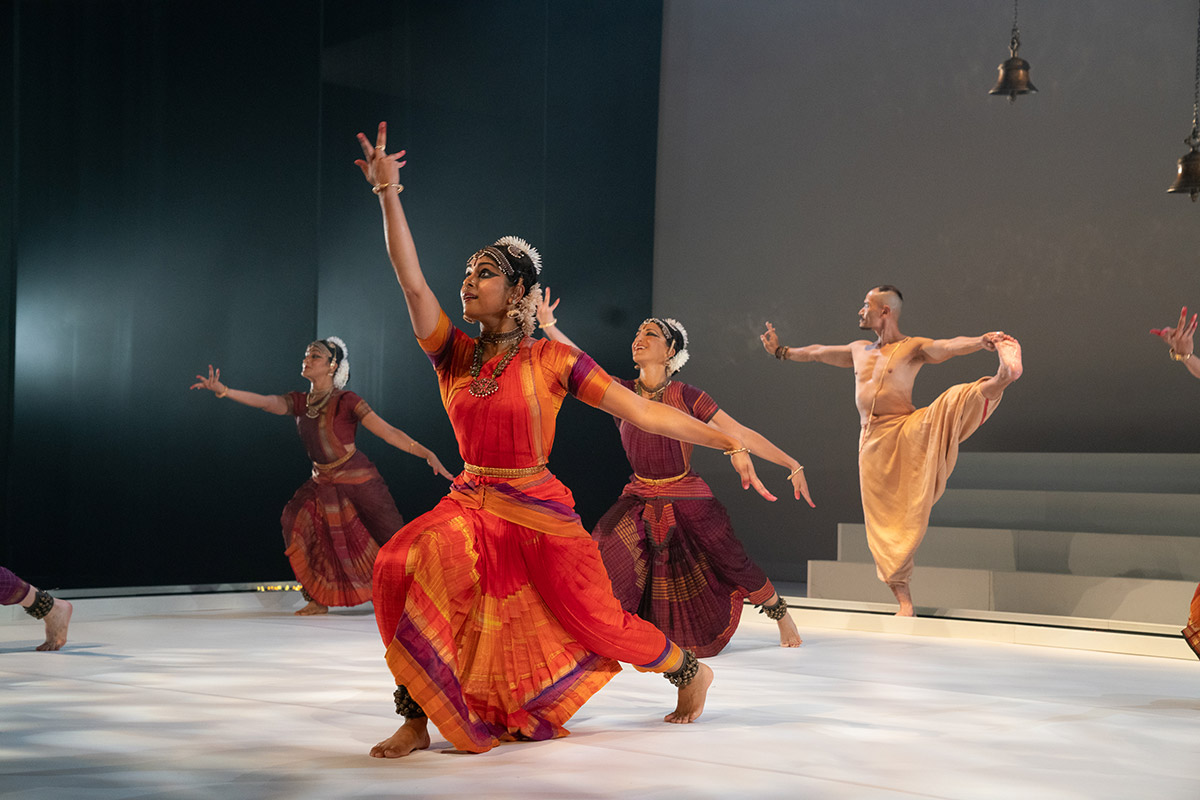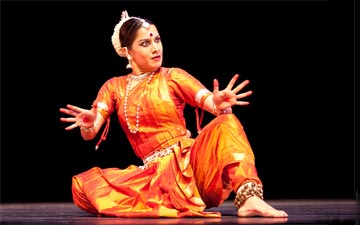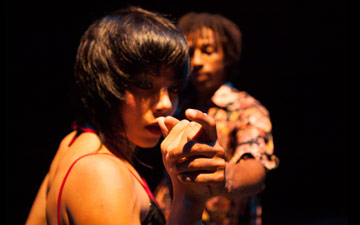
© Steven Pisano. (Click image for larger version)
Ragamala Dance Company
Fires of Varanasi: Dance of the Eternal Pilgrim
★★★✰✰
New York, Joyce Theater
22 September 2021
www.ragamaladance.org
www.joyce.org
The Joyce Theater reopened its doors on September 22nd to initiate its Fall ’21 season after remaining dark for 18 months due to Covid-19. With adherence to advance notification of New York City’s current health and safety precautions requiring proof of vaccination and the wearing of masks inside the theater, an indomitable dance audience returned to welcome a timely production by Ragamala Dance Company─Fires of Varanasi: Dance of the Eternal Pilgrim.
Why was this production timely? Varanasi is a sacred city in India where people bring their dead for crematory rites─the ashes to be poured into the river Ganges to merge into its ever-flowing continuum. Varanasi is also a place of pilgrimage, where thousands come to bathe in those same holy waters and achieve purification. The pandemic has gouged a deep and painful loss in communities throughout the globe; the city of Varanasi and its rituals of death and renewal offer inspiration for transmuting loss into regenerative possibility.

© Steven Pisano. (Click image for larger version)
Ranee and Aparna Ramaswamy are the Ragamala mother-daughter partnership that shares the responsibilities of artistic direction, creation, and choreography for the Bharatanatyam-trained company based in Minnesota. The idea for this dance grew from the death of Ranee’s father (Aparna’s grandfather), a devout Hindu living faraway from his spiritual homeland. His final wish was for his ashes to be scattered in the Ganges just as were those of his ancestors before him. The artists were inspired to create a choreographic expression of the ritual experience and spiritual transcendence that are part of their Hindu heritage.
Varanasi is identified with its ghats, or steps, which descend from the temples down to the Ganges River lined with funeral pyres. The stage design by Willy Cessa neatly distilled the visual essence of the sacred city. Smoke wafted across the upper third of the stage suggesting the ever-present haze from the crematory fires while a wide set of steps ran across the upstage border abutting the pearly-white backdrop. A shallow rectangular pool of water was situated beside the base of the steps and two more were positioned along the sides of the stage. Brass ritual pots sat in the water and antique brass bells hung at varying lengths from the ceiling.
Mystical Vedic mantras chanted to a droning harmonium set a meditative tone as eleven dancers entered in various groupings. Some carried brass pots emitting smoke, others entered with palms pressed together at the heart in the anjali mudra, and others descended the stairs to bend down and cup water in their hands. The spiritual convocation got underway as the dancers bearing pots raised and circled them with heads bowed imbuing the space with spirals of smoke and the spirit of offering.
The emergence of daybreak was communicated through energetic sounds of percussion and a shift to warm lighting bringing into view the radiant colors of the dancers’ saris. The crimson and gold pleated silks with glittering ornaments were an eyeful. A sequence of unison dancing, enlivened by the strong rhythmic footwork, turning bodies, and narrative hand gestures of the Bharatanatyam South Indian dance form, brought to life the activity of the locale. Lit projections of rippling water animated the backdrop as a group of dancers knelt beside the pools to pour water offerings while Surya the Sun (God) rode his chariot across the sky. Company co-director Aparna Ramaswamy danced this solo. In spite of motioning the recognizable drama, she did not project the sun’s fiery glory beyond the stage.

© Steven Pisano. (Click image for larger version)
Ranee Ramaswamy, the mother half of the Ragamala artistic team, performed an abhinaya (mimetic) solo evoking the deity Shiva with detailed skill. Her hands flowed with liquid motion as she gestured the mythological birth of the Ganges River from her (Lord Shiva’s) topknot. In an instant, she transitioned to the role of devotee meticulously grinding the sandalwood paste, which she lovingly applied to her divine lord’s body. But again, her performance failed to extend beyond her personal space. In the background, four dancers performed ritual ablutions in unison.
A wonderfully evocative tableau of ritual activity developed as rippling water projections swirled in a circular pattern on the floor. The custom of making offerings to initiate spiritual encounter was well-staged with one group dancing gestures of music-making on finger cymbals and drums while others performed a water offering sequence. A dancer splashing through the length of a pool kicking her bell-laden ankles through the water broke the ritual spell and provided a down-to-earth respite.
Ashwini Ramaswamy, the younger founding Ragamala member and choreographic associate, re-charged the performance with sparkling energy in a solo evoking the flute-playing Lord Krishna. She filled the stage with her generous movements, unwavering technique, and clearly projected narrative.

© Steven Pisano. (Click image for larger version)
Several dancers, clad in the simple white cotton garments of spiritual pilgrims, moved through a slow-motion, meditative sequence of yogic poses and mimed action of rowing on the river, ritual immersion, and the pouring of ashes from a pot. This thread of inner journey provided a striking contrast to the life-affirming rhythms of regeneration danced by those in brilliant colors. Aparna Ramaswamy’s final solo homage to Shiva─the reigning deity of Varanasi and cosmic dancer of destruction and creation─added another layer of interplay to this richly textured composition.
Fires of Varanasi: Dance of the Eternal Pilgrim was masterfully composed but underwhelmingly performed. The solo performers require a higher energy output to give the audience the intended experience of ecstatic liberation. After all, they are dancing the gods. I hope that as the Ragamala dancers tour the piece and get back in the groove of performing live, they will generate the necessary voltage to fulfill the dance’s and their own achievable potential.

















You must be logged in to post a comment.